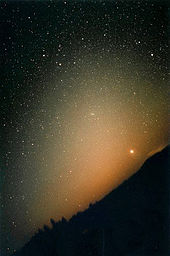Interplanetary dust

As interplanetary dust refers to dust-like matter from our solar system with masses below 10 -5 g and radii microns below the 100th It is part of the interplanetary medium .
properties
Probably the most important source of interplanetary dust are comets , asteroids and other small bodies, as well as fragments that are formed when larger particles collide. In addition, particles close to the sun can evaporate from larger pieces of matter.
The dust particles do not remain permanently in the solar system: very small dust particles are driven outwards by the radiation pressure of the sunlight, larger ones approach the sun more and more due to the Poynting-Robertson effect and are evaporated or fragmented there.
An accumulation of interplanetary dust about 2.5 AU away from the sun is responsible for the zodiacal light , which is sunlight reflected from the dust.
exploration
With the help of dust detectors on satellites , the interplanetary dust can be analyzed. Some of these particles contain, among others, polycyclic aromatic hydrocarbons . In some cases, dust particles can also be picked up by airplanes at a height of around 20 km, such as the mineral Brownleeit , which was previously undetected on earth . Further analysis options are the examination of microscopic impact craters on the moon and observations with satellites in the infrared range .
Depending on the estimate, 100 to 10,000 tons of matter in the form of micrometeorites hit the earth every day . Because small particles of air resistance against the force of gravity prevails, they do not burn up in the Earth's atmosphere , but float to the ground, but are difficult there from terrestrial debris to distinguish.
See also
literature
- Eva Ahnert-Rohlfs : Preliminary communication on experiments to detect meteoritic dust . Sonneberg observatory 1954 (communication from the Sonneberg observatory; vol. 45).
- Eberhard Grün : Interplanetary dust. Springer, Berlin 2001, ISBN 3-540-42067-3 .
- Kazuo Yamakoshi: Extraterrestrial dust - laboratory studies of interplanetary dust. Terra Scientific Publ., Tokyo 1994, ISBN 0-7923-2294-0 .
Web links
Individual evidence
- ↑ Thomas Henning: Astromineralogy. Springer, Berlin 2003, ISBN 3-540-44323-1 ; @google books , accessed November 18, 2011.
- ^ Arnold Hanslmeier : Introduction to Astronomy and Astrophysics. Spektrum Akad. Verl., Berlin 2002, ISBN 3-8274-1127-0
- ^ Joachim Herrmann: Dtv-Atlas Astronomie. 14th edition, Ger. Taschenbuch-Verl., Munich 2000, ISBN 978-3-423-03006-9 , p. 135
- ^ Arnold Hanslmeier: Introduction to Astronomy and Astrophysics. Spektrum Akad. Verl., Berlin 2002, ISBN 3-8274-1127-0 , p. 171 ff.